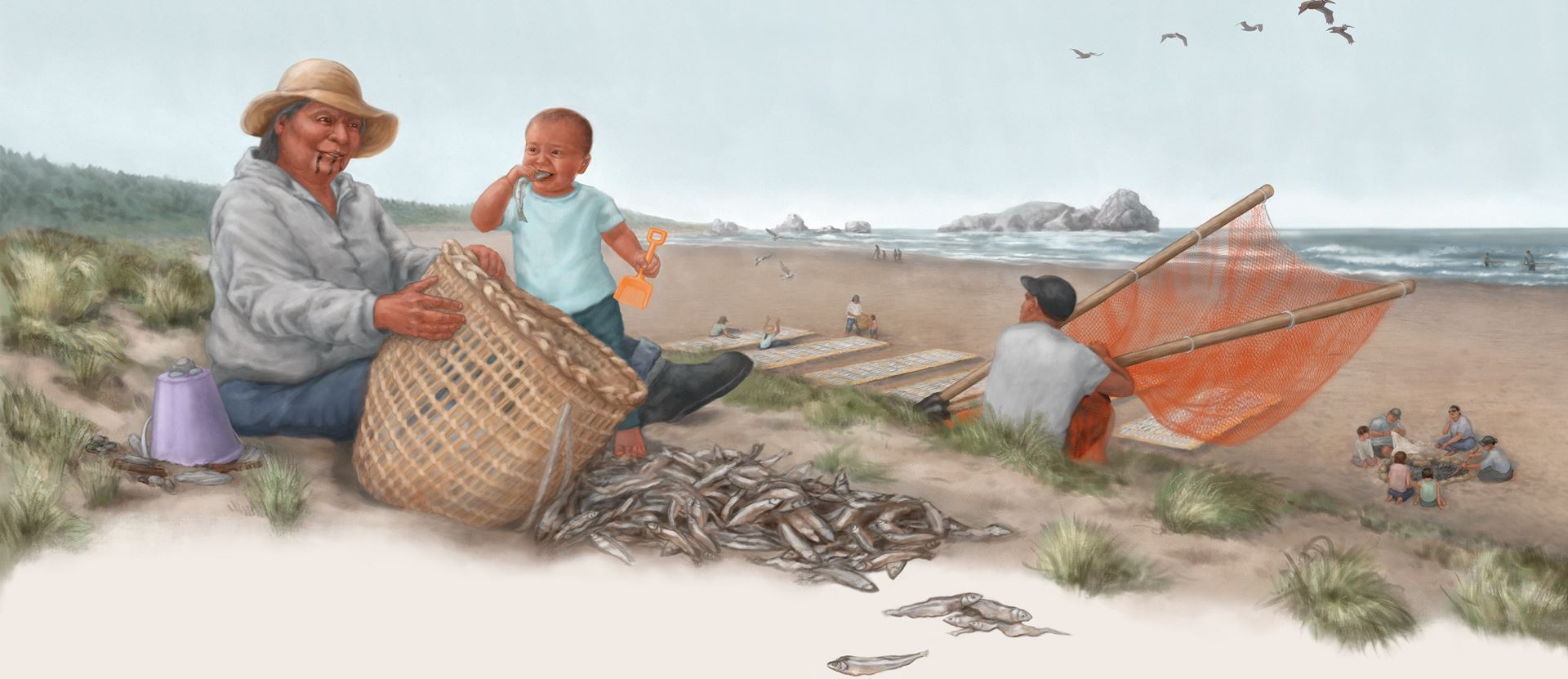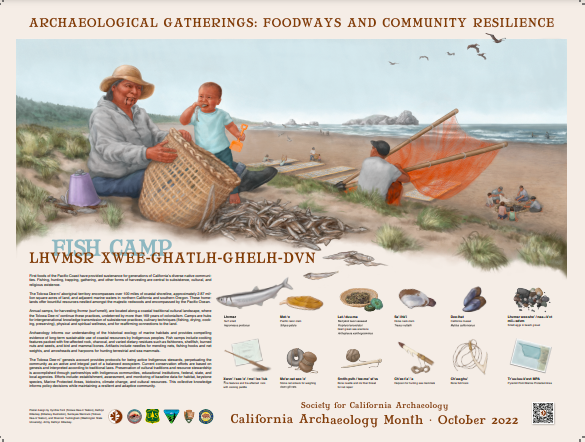2022 ARCHAEOLOGY POSTER

The 2022 California Archaeology Month poster was inspired by the 2022 SCA Annual Meeting theme, Archaeological Gatherings: Foodways and Community Resilience. The poster design honors first foods of the Pacific Coast, which have provided sustenance for generations of California’s diverse native communities. The scene features coastal surf smelt fishing in northern California and includes images and materials directly relevant to the Tolowa Dee-Ni’ Tribal community.
Poster Design and Artwork
The design was developed by a collaborative team--Cynthia Ford (Tolowa Dee-ni’ Nation), Kathryn Killackey (Killackey Illustration), Suntayea Steinruck (Tolowa Dee-ni’ Nation), and Shannon Tushingham (SCA President, Washington State University)— over months of discussions and conversations about smelt fishing, past and present. Each artifact, item, gesture, and activity featured on the poster has a story, and the group relied upon the skills of artist Kathryn Killackey (Killackey Illustration) to capture each detail.
Poster

To purchase a complete and full-size poster of the cover art, go to https://sfca.wildapricot.org/store
Background: Tolowa Dee-ni’ Surf Smelt Fishing
The poster scene takes place at a traditional surf smelt camp in far northwest California. More specifically, it is set in the Taa-laa-waa-dvn (aboriginal territory) of the Tolowa Dee-ni' people, which encompasses over 100 miles of coastal shoreline and approximately 2.87 million square acres of land and an undefined acreage of marine waters in northern California and southern Oregon. The homelands of the Tolowa Dee-ni’ and other neighboring tribes offer bountiful resources nestled amongst the majestic redwoods and encompassed by the Pacific Ocean.
Surf smelt fishing is an ancient and living tradition that persists every summer on the beaches of far northern California. Along with other fishing, hunting, trapping, and gathering practices, surf fishing is central to the subsistence, cultural, and religious existence of the community.
Lhvmsr Xwee-ghatlh-ghelh-dvn (Fish Camp) is an annual beach camp for harvesting primarily lhvmsr /smelt/Hypomesus pretiosus and various other marine resources. The bulk storage and mass capture of small forage fish has played a primary role in the cultural traditions and subsistence practices of ancient and modern indigenous communities throughout the world. In northern California, these practices involve the use of V-shaped dip nets to mass harvest surf smelt, which spawn along sandy beaches in the late summer. Archaeological data from village sites and fish camps demonstrate the deep time history of smelt fishing and sustainable harvesting practices on the North Coast.
Camps are hubs for intergenerational knowledge transmission of: subsistence practices, culinary techniques such as dip-net and line fishing, sun drying, cooking in sand and gravel fire pits, sharing of oral stories and genealogy, physical and spiritual wellness, and securing food supply and trading commodities. This is a traditional cultural landscape that the Tolowa Dee-ni' continue to steward, despite more than 169 years of colonialism, transformations of the landscape, and impacts of climate change.
Archaeology and History of Smelt Fishing
Archaeology informs our understanding of the historical ecology of marine habitats and provides compelling evidence of long-term sustainable use of coastal resources by Indigenous peoples. Fish camps include cooking features packed with fire-affected rock, charcoal, and varied dietary residues such as fishbones, shellfish, burned nuts and seeds, and bird and mammal bones. Artifacts include needles for mending nets, fishing hooks and net weights, and arrowheads and harpoons for hunting terrestrial and sea mammals.
Ethnographic accounts from the turn of the 20th century show that smelt provided a substantial portion of the native diet. A "lucky dip" with an A-frame scoop net could produce 40-50 pounds of small surf fish. While the importance of mass harvested smelt in diet of ethnographic Native Americans is well documented, their significance in the past (until recently) has been underappreciated. Seasonal smelt camps are fragile, ephemeral, and highly vulnerable to coastal erosion and climate change. Because smelt bone is small, it is typically overlooked using traditional archaeological sampling techniques. However, the application of fine-grained screening techniques, has led to the discovery of tiny smelt bones—often in staggering numbers—at numerous coastal surf fish camps and villages sites in northwestern California. Ancient DNA analysis of fishbone has provided species-level identification of fishbone, which provides important historical data on these fish populations and sustainable use by humans over archaeological time use by humans over archaeological time scales.
Stewardship
The ubiquity and abundance of smelt bone at numerous coastal archaeological sites years ago through protohistoric times that small forage fish were sustainably harvested for generations at coastal sites in northwestern California. Indigenous stewardship of North Coastal environments declined as populations faced displacement from ancestral villages and denial of access to coastal resources, major upheavals due to disease, violence, and forced removals. Forage fish populations also declined, at often alarming rates. This is important because forage fish, including smelt, are keystone species, meaning that they are indicators of the overall health of marine habitats. They are also quite vulnerable to complex factors--including climate change, habitat disturbance, and other natural and human-induced impacts.
Today, many indigenous peoples take active roles as managers of local habitats, cultural burning, and fisheries and wildlife management and restoration efforts. For the Tolowa Dee-ni’, the foundation and philosophy of conservation efforts are based on principles outlined in the account of the Tolowa Dee-ni' genesis, passed down orally over countless generations. Traditional knowledge and laws, best available science, and an adaptive approach informs stewardship and conservation efforts. The people remain connected to ancestral villages, camps, and other places on the landscape. Tolowa Dee-ni' hold aboriginal rights to the lands, waters, air and resources within Taa-laa-waa-dvn, which were never ceded. Efforts focus on preservation of cultural traditions, resiliency, food sovereignty, sustainability, wellness and broader cultural and natural resources stewardship accomplished through partnerships with Indigenous communities, educational institutions, Federal, State and local agencies such as: UDALL Foundation, West Coast Ocean Partnership, US Fish and Wildlife, Bureau of Indian Affairs, Administration for Native Americans, Resources Legacy Foundation, Packard Foundation, SCRIPPS Institute of Oceanography, Humboldt State University, Portland State University, Tribal Marine Stewards Network, KUA, and the California Department of Public Health. Efforts include assessments of baseline data for surf smelt habitat and spawning runs, baseline characterization for keystone species and marine habitats, establishment and monitoring of Marine Protected Areas, monitoring, and reporting of biotoxins, E-DNA sampling, climate change, cultural resources surveys, and preparation these landscapes for nomination to the Federal Register.
Still curious? Check out some of these resources and materials:
Stewards of the Wild Sea-North Coast Tribal Leadership Protecting Our Ocean Wilderness – https://www.youtube.com/watch?v=vWYxjEaip7g
KCET Tending Nature- Protecting the Coast with the Tolowa Dee-ni’ –https://www.kcet.org/shows/tending-nature/episodes/protecting-the-coast-with-the-tolowa-dee-ni
MPA Collaborative Network – Humboldt/Del Norte Tribal Traditions –https://www.mpacollaborative.org/project/tolowa-dee-ni-nation-video/
Civil Eats- A Native Community Preserves its Food Traditions- https://civileats.com/2017/11/21/a-native-community-preserves-its-food-traditions/
Tolowa Dee-ni’ Nation Lhvmsr Habitat Assessment: Establishing Baseline Data for Spawning Runs of Surf Smelt-https://escholarship.org/content/qt70m5d8tq/qt70m5d8tq.pdf
Collaborative Historical Ecology: A Case Study of Academic, Tribal, and Federal Agency Research and Management at an Endangered Archaeological Village Site on the North Coast of California (NPS Webinar) - https://www.nps.gov/articles/000/tushingham-et-al-collaborative-historical-ecology.htm
How Climate Change Threatens Coastal Archeological Sites- https://www.klcc.org/2016-05-12/how-climate-change-threatens-coastal-archeological-sites
The Sweetwater Site: Archaeological Recognition of Surf Fishing and Temporary Smelt Camps on the North Coast of California- https://escholarship.org/uc/item/1fx5f75g
Human use of small forage fish: Improved ancient DNA species identification techniques reveal long term record of sustainable mass harvesting of smelt fishery in the northeast Pacific Rim- Human use of small forage fish: Improved ancient DNA species identification techniques reveal long term record of sustainable mass harvesting of smelt fishery in the northeast Pacific Rim - ScienceDirect
EcoTrust- West Coast Tribes taking lead on marine planning- https://ecotrust.org/west-coast-tribes-taking-lead-on-marine-planning/
Ocean Protection Council Tribal Marine Stewards Network Pilot Program- https://opc.ca.gov/webmaster/ftp/pdf/agenda_items/20200619/Item6a_TribalMarineStewardsNetwork_FINAL.pdf
